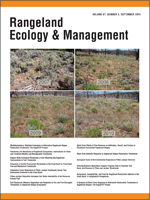If arid sagebrush ecosystems lack resilience to disturbances or resistance to annual invasives, then alternative successional states dominated by annual invasives, especially cheatgrass (Bromus tectorum L.), are likely after fuel treatments. We identified six Wyoming big sagebrush (Artemisia tridentata ssp. wyomingensis Beetle & Young) locations (152–381 mm precipitation) that we believed had sufficient resilience and resistance for recovery. We examined impacts of woody fuel reduction (fire, mowing, the herbicide tebuthiuron, and untreated controls, all with and without the herbicide imazapic) on short-term dominance of plant groups and on important land health parameters with the use of analysis of variance (ANOVA). Fire and mowing reduced woody biomass at least 85% for 3 yr, but herbaceous fuels were reduced only by fire (72%) and only in the first year. Herbaceous fuels produced at least 36% more biomass with mowing than untreated areas during posttreatment years. Imazapic only reduced herbaceous biomass after fires (34%). Tebuthiuron never affected herbaceous biomass. Perennial tall grass cover was reduced by 59% relative to untreated controls in the first year after fire, but it recovered by the second year. Cover of all remaining herbaceous groups was not changed by woody fuel treatments. Only imazapic reduced significantly herbaceous cover. Cheatgrass cover was reduced at least 63% with imazapic for 3 yr. Imazapic reduced annual forb cover by at least 45%, and unexpectedly, perennial grass cover by 49% (combination of tall grasses and Sandberg bluegrass [Poa secunda J. Presl.]). Fire reduced density of Sandberg bluegrass between 40% and 58%, decreased lichen and moss cover between 69% and 80%, and consequently increased bare ground between 21% and 34% and proportion of gaps among perennial plants > 2 m (at least 28% during the 3 yr). Fire, mowing, and imazapic may be effective in reducing fuels for 3 yr, but each has potentially undesirable consequences on plant communities.
How to translate text using browser tools
1 September 2014
Region-Wide Ecological Responses of Arid Wyoming Big Sagebrush Communities to Fuel Treatments
David A. Pyke,
Scott E. Shaff,
Andrew I. Lindgren,
Eugene W. Schupp,
Paul S. Doescher,
Jeanne C. Chambers,
Jeffrey S. Burnham,
Manuela M. Huso
Bromus tectorum
fire
imazapic
mowing
resistance and resilience
Tebuthiuron





